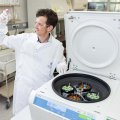University of Queensland researchers today (August 16) claimed success for the world`s first flight test of supersonic combustion, the process used in an air-breathing supersonic ramjet engine, known as a scramjet.
“Our honest understanding from preliminary data is that the experiment worked,” said international HyShot™ program leader Dr Allan Paull, of UQ’s Centre for Hypersonics.
“We received data for the full length of the 10-minute flight. All indications are that supersonic combustion occurred. We’ll now be submitting the results to international peer review.”
On July 30 a safe and successful launch of a Terrier Orion Mk 70 rocket containing a scramjet payload was held at Department of Defence’s Woomera Instrumented Range, 500km north of Adelaide, in the South Australian desert.
The aim of the HyShot™ program is to provide the world’s first in-flight tests of scramjet technology, validating experiments held in ground test facilities.
While scramjets raise the possibility of Sydney to London flights in two hours, they are set to revolutionise the launch of small space payloads, such as communications satellites, by substantially lowering costs. They have the added benefit that they do not even have to carry most of their propellant as they use oxygen from the atmosphere.
University of Queensland Vice-Chancellor Professor John Hay congratulated the international HyShot™ team on its success, which he said put Australia at the forefront of this new technology and enhanced the country’s international prestige in space research.
“It’s a magnificent example of international collaboration, involving researchers from Australia, the United States, Britain, France, Germany, Korea and Japan,” he said.
Professor Hay is chair of the Group of Eight, Australia’s leading research-intensive universities which produce the majority of Australian scientific research.
“Australia has proved we can develop this technology at a fraction of the cost of overseas programs. We must now build on success and secure the program in Australia so the intellectual property is not lost to the country. The danger is that the program could move offshore.
“Dr Paull has received approaches from top Australian researchers based in NASA, Boeing and other organizations keen to return to Australia to work on the HyShot program if suitable funding is available.”
Professor Hay said these researchers were trained at UQ’s Centre for Hypersonics, which is directed by Professor Richard Morgan. This is the largest group of hypersonics researchers in Australia and the largest University-based hypersonics group in the world, with some of the world’s most advanced equipment for simulating velocities of eight times the speed of sound to 50 times the speed of sound, the speeds experienced by reentry vehicles such as space shuttles and after interplanetary missions.
“HyShot™ provides a significant opportunity for Australia to reverse the brain drain,” Professor Hay said.
Dr Paull said he was negotiating with various groups to conduct an extensive, ongoing and advanced $50 million program of six flights over five years, leading to a free flying scramjet engine. The program would provide information to determine a cost effective launcher based in northern Australia to launch small, lightweight satellites.
“The program has generated lot of international interest,” he said. “We currently don’t have funding for future flights, but the Japanese, through NAL, have provided funding to build a new payload.” Dr Paull will visit international collaborators in the next few weeks for talks on future flight programs.
The recent HyShot™ launch was designed to take the scramjet engine to a speed of Mach 7.6 (or more than seven times the speed of sound) for the experiment, using a Terrier Orion rocket. The rocket and payload reached an altitude of 314km before the rocket was configured to fly in a new trajectory pointing the payload back down to earth. The flight experiment took place within only the last few seconds of the flight, lasting almost 10 minutes.
After the Terrier booster had finished its work and subsequently fell 5km downrange, the Orion continued on with the scramjet payload and impacted some 370km downrange of the launch site, very close to the nominal impact point predicted by the scientists.
Radar and four sets of telemetry (radio) tracked the flight. One telemetry station was at Woomera Instrumented Range, while three telemetry officers were stationed at three points of a triangle more than 300km downrange in the middle of the desert. They not only captured the final seconds when the experiment occurred, but one site, to its credit, also captured all but the first 15 seconds of the flight.
Dr Paull said this was a “tremendous achievement.”
“All those who were involved in producing this most exciting result are to be commended,” he said.
After everyone had gone home, the researchers faced a nail-biting wait for the telemetry officers to come in from the dust with their precious data, before analysis could occur.
Dr Paull said everything appeared to have worked to plan, with only a minor glitch of a horizon sensor to turn the rocket failing half way through the flight, but a backup system had kicked in, using all their software capabilities.
Astrotech Space Operations senior engineer Dr Morgan Windsor said the job that so few with so little undertook was incredible and the fact that it worked was almost anti-climactic.
“Allan said a number of times that just getting the payload launched was a great success and indeed it was. But now that he has achieved combustion in flight this represents a huge accomplishment and a first internationally. I am so pleased that I had the opportunity this late in my career to support UQ, Allan and his team and have not sensed a greater feeling of accomplishment,” Dr Windsor said.
Professor Hay and Dr Paull thanked all consortium partners and sponsors, in particular:
• Astrotech Space Operations/DTI
• QinetiQ
• Defence Science and Technology Organisation (DSTO)
• Defence Corporate Support
• Aircraft Research and Development Unit, Australian Defence (ARDU)
• the Australian Research Council
• NASA Langley Research Center
• NAL (National Aerospace Lab. Japan)
• AFRL (Air Force Research Laboratory, USA)
• DLR (German Aerospace Center)
• Seoul National University
• DISR
• Australian Space Research Institute (ASRI)
• BAE Systems Australia
• Alesi Technologies
• GASL
• Aerospatiale Matra
• NQEA
• UniQuest
• Institution of Engineers Australia (Queensland)
• Jet Air Cargo
• AECA
• Luxfer Australia
Media contacts:
UQ Communications - Jan King, telephone 0413 601 248 or 07 3365 1120, Peter McCutcheon, telephone 07 3365 1088 or 0413 380012
Hyshot™ stories are available at www.uq.edu.au/hyshot. Photos, attributed to The University of Queensland (photographer Chris Stacey), can be downloaded from https://www.uq.edu.au/news/hyshot/hyshot-gallery.php



